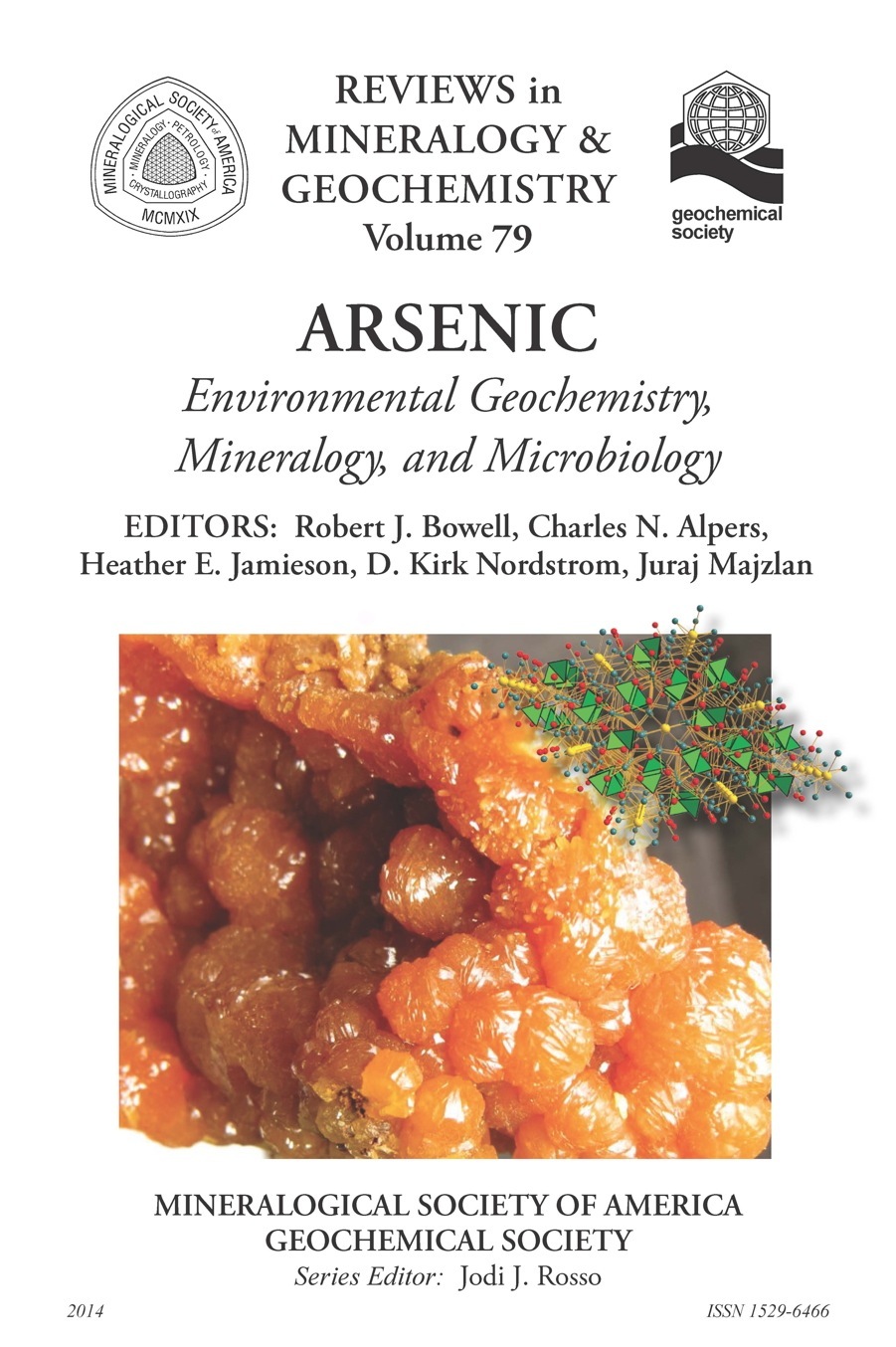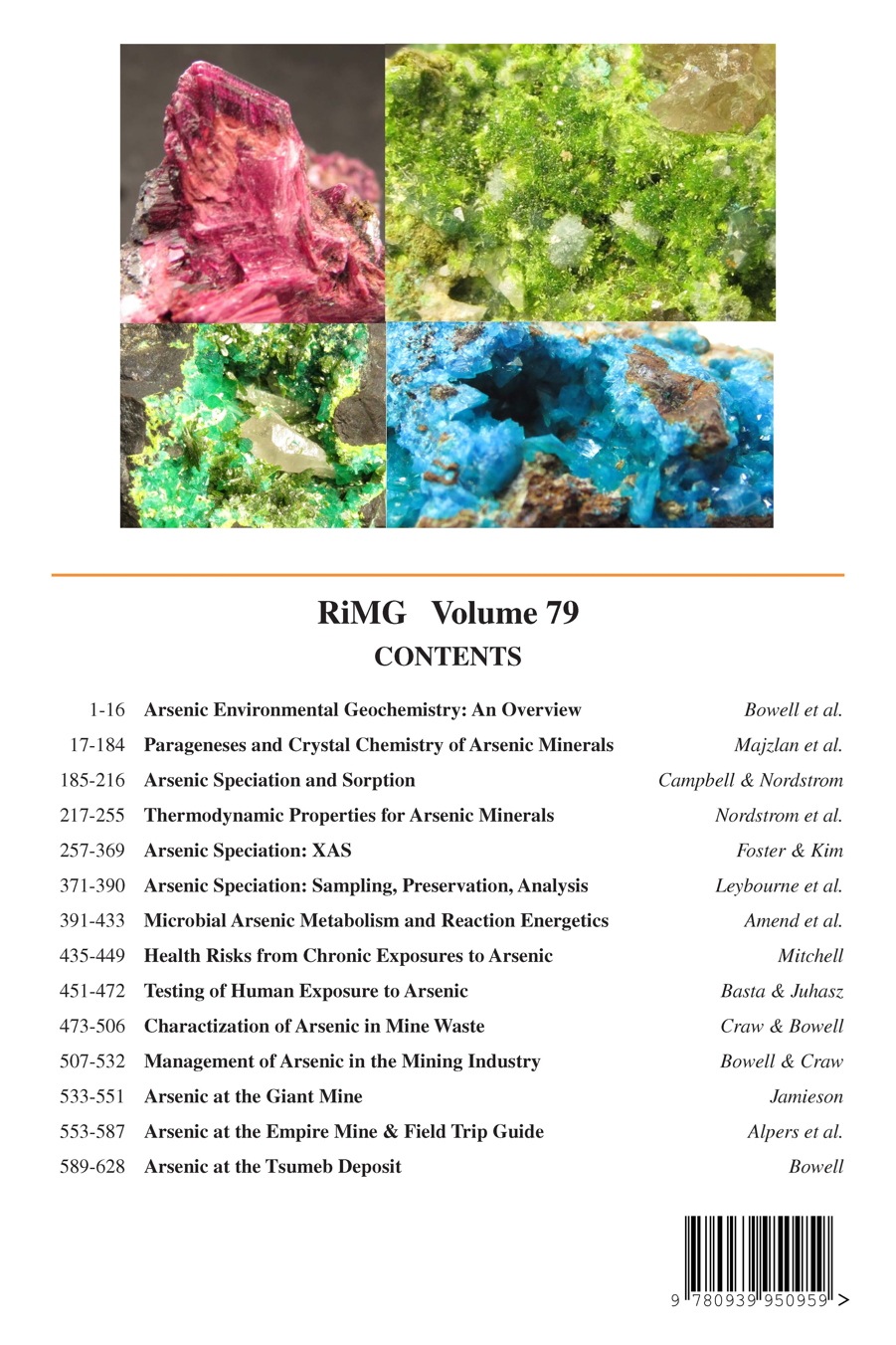

Mineralogical Society of America, Founded December 30, 1919
Order Publications Online (25% discount for MSA, CMS and GS members, except shipping)
MinPubs.org Pay-Per-View GeoScienceWorld Pay-Per-View


2014, i-xvi + 635 pages. ISBN 978-0-939950-94-2
Arsenic is perhaps history’s favorite poison, often termed the "King of Poisons" and the "Poison of Kings" and thought to be the demise of fiction’s most famous ill-fated lovers. The toxic nature of arsenic has been known for millennia with the mineral realgar (AsS), originally named “arsenikon” by Theophrastus in 300 B.C.E. meaning literally "potent." For centuries it has been used as rat poison and as an important component of bactericides and wood preservatives. Arsenic is believed to be the cause of death to Napoleon Bonaparte who was exposed to wallpaper colored green from aceto-arsenite of copper (Aldersey-Williams 2011). The use of arsenic as a poison has been featured widely in literature, film, theatre, and television. Its use as a pesticide made it well known in the nineteenth century and it was exploited by Sir Arthur Conan Doyle in the Sherlock Holmes novel The Golden Pince-Nez (Conan-Doyle 1903). The dark comedy Arsenic and Old Lace is a prime example of arsenic in popular culture, being first a play but becoming famous as a movie.
Arsenic has figured prominently not only in fiction but in historical crimes as well (Kumar 2010). A high profile case of the mid-nineteenth century involved a hydrotherapist, Dr. Thomas Smethurst, who was accused of using arsenic to poison a woman he had befriended (Wharton 2010). Based on analytical evidence from a renowned toxicologist, Alfred Swaine Taylor, a death sentence was imposed, however Taylor had to confess that his apparatus was contaminated. The verdict was overturned after public opinion was voiced against it and a plea for clemency was made to Queen Victoria.
In recent years, arsenic has been recognized as a widespread, low-level, natural groundwater contaminant in many parts of the world, particularly in places such as West Bengal and Bangladesh, where it has given rise to chronic human-health issues. Long-term exposure to arsenic has been shown to cause skin lesions, blackfoot disease, and cancer of the skin, bladder, and lungs, and is also associated with developmental effects, cardiovascular disease, neurotoxicity, and diabetes (WHO 2012). Arsenate's toxicity is caused by its close chemical similarities to phosphate; it uses a phosphate transport system to enter cells. Arsenic occurs in many geological environments including sedimentary basins, and is particularly associated with geothermal waters and hydrothermal ore deposits. It is often a useful indicator of proximity to economic concentrations of metals such as gold, copper, and tin, where it occurs in hydrothermally altered wall rocks surrounding the zones of economic mineralization. Arsenic is commonly a persistent problem in metal mining and there has been significant effort to manage and treat mine waste to mitigate its environmental impacts.
This volume compiles and reviews current information on arsenic from a variety of perspectives, including mineralogy, geochemistry, microbiology, toxicology, and environmental engineering. The first chapter (Bowell et al. 2014) presents an overview of arsenic geochemical cycles and is followed by a chapter on the paragenesis and crystal chemistry of arsenic minerals (chapter 2; Majzlan et al. 2014). The next chapters deal with an assessment of arsenic in natural waters (chapter 3; Campbell and Nordstrom 2014) and a review of thermodynamics of arsenic species (chapter 4; Nordstrom et al. 2014). The next two chapters deal with analytical measurement and assessment starting with measuring arsenic speciation in solids using x-ray absorption spectroscopy (chapter 5; Foster and Kim 2014). Chapter 6 (Leybourne and Johannesson 2014) presents a review on the measurement of arsenic speciation in environmental media: sampling, preservation, and analysis. In chapter 7 (Amend et al. 2014) there is a review of microbial arsenic metabolism and reaction energetics. This is followed by an overview of arsenic toxicity and human health issues (chapter 8; Mitchell 2014) and an assessment of methods used to characterize arsenic bioavailability and bioaccessibility (chapter 9; Basta and Jurasz 2014). This leads into chapter 10 (Craw and Bowell 2014), which describes the characterization of arsenic in mine waste with some examples from New Zealand, followed by a chapter on the management and treatment of arsenic in mining environments (chapter 11; Bowell and Craw 2014). The final three chapters are in-depth case studies of the geochemistry and mineralogy of legacy arsenic contamination in different historical mining environments: the Giant gold mine in Canada (chapter 12; Jamieson 2014), the Sierra Nevada Foothills gold belt of California (chapter 13; Alpers et al. 2014), and finally, the hydrogeochemistry of arsenic in the Tsumeb polymetallic mine in Namibia (chapter 14; Bowell 2014).
Title Page
p. i
Copyright
p. ii
From the Series Editor & Preface
p. iii - vi
Table of Contents
p. vii - xvi
Chapter 1. The Environmental Geochemistry of Arsenic: An Overview
by Robert J. Bowell, Charles N. Alpers, Heather E. Jamieson, D. Kirk Nordstrom, Juraj Majzlan, p. 1 - 16
Chapter 2. Parageneses and Crystal Chemistry of Arsenic Minerals
by GJuraj Majzlan, Petr Drahota, Michal Filippi, p. 17 - 184
Chapter 3. Arsenic Speciation and Sorption in Natural Environments
by Kate M. Campbell, D. Kirk Nordstrom, p. 185 - 216
Chapter 4. Thermodynamic Properties for Arsenic Minerals and Aqueous Species
by D. Kirk Nordstrom, Juraj Majzlan, Erich Koenigsberger, p. 217 - 256
Chapter 5. Arsenic Speciation in Solids Using X-ray Absorption Spectroscopy
by Andrea L. Foster and Christopher S. Kim, p. 257 - 370
Chapter 6. Measuring Arsenic Speciation in Environmental Media: Sampling, Preservation, and Analysis
by Matthew I. Leybourne, Karen H. Johannesson, and Alemayehu Asfaw, p. 371 - 390
Chapter 7. Microbial Arsenic Metabolism and Reaction Energetics
by Jan P. Amend, Chad Saltikov, Guang-Sin Lu, and Jaime Hernandez, p. 391 - 434
Chapter 8. Health Risks Associated with Chronic Exposures to Arsenic in the Environment
by Valerie L. Mitchell, p. 435 - 450
Chapter 9. Using In Vivo Bioavailability and/or In Vitro Gastrointestinal Bioaccessibility Testing to Adjust Human Exposure to Arsenic from Soil Ingestion
by Nicholas T. Basta and Albert Juhasz, p. 451 - 472
Chapter 10. The Characterization of Arsenic in Mine Waste
by Dave Craw and Robert J. Bowell p. 473 - 506
Chapter 11. The Management of Arsenic in the Mining Industry
by Robert J. Bowell and Dave Craw, p. 507 - 532
Chapter 12. The Legacy of Arsenic Contamination from Mining and Processing Refractory Gold Ore at Giant Mine, Yellowknife, Northwest Territories, Canada
by Heather E. Jamieson, p. 533 - 549
Chapter 13. Arsenic Associated with Historical Gold Mining in the Sierra Nevada Foothills: Case Study and Field Trip Guide for Empire Mine State Historic Park, California
by Charles N. Alpers, Perry A. Myers, Daniel Millsap, and Tamsen Burlak Regnier, p. 553 - 5
Chapter 14. Hydrogeochemistry of the Tsumeb Deposit: Implications for Arsenate Mineral Stability
by Robert J. Bowell, p. 589 - 628
Index of Minerals. , p. 629 - 635
Index of Minerals as a pdf (Download (99 KB))